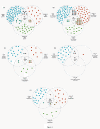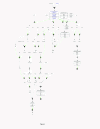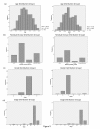Biomarker robustness reveals the PDGF network as driving disease outcome in ovarian cancer patients in multiple studies
- PMID: 22236809
- PMCID: PMC3298526
- DOI: 10.1186/1752-0509-6-3
Biomarker robustness reveals the PDGF network as driving disease outcome in ovarian cancer patients in multiple studies
Abstract
Background: Ovarian cancer causes more deaths than any other gynecological cancer. Identifying the molecular mechanisms that drive disease progress in ovarian cancer is a critical step in providing therapeutics, improving diagnostics, and affiliating clinical behavior with disease etiology. Identification of molecular interactions that stratify prognosis is key in facilitating a clinical-molecular perspective.
Results: The Cancer Genome Atlas has recently made available the molecular characteristics of more than 500 patients. We used the TCGA multi-analysis study, and two additional datasets and a set of computational algorithms that we developed. The computational algorithms are based on methods that identify network alterations and quantify network behavior through gene expression.We identify a network biomarker that significantly stratifies survival rates in ovarian cancer patients. Interestingly, expression levels of single or sets of genes do not explain the prognostic stratification. The discovered biomarker is composed of the network around the PDGF pathway. The biomarker enables prognosis stratification.
Conclusion: The work presented here demonstrates, through the power of gene-expression networks, the criticality of the PDGF network in driving disease course. In uncovering the specific interactions within the network, that drive the phenotype, we catalyze targeted treatment, facilitate prognosis and offer a novel perspective into hidden disease heterogeneity.
Figures





Similar articles
-
Pathway Relevance Ranking for Tumor Samples through Network-Based Data Integration.PLoS One. 2015 Jul 28;10(7):e0133503. doi: 10.1371/journal.pone.0133503. eCollection 2015. PLoS One. 2015. PMID: 26217958 Free PMC article.
-
ICan: an integrated co-alteration network to identify ovarian cancer-related genes.PLoS One. 2015 Mar 24;10(3):e0116095. doi: 10.1371/journal.pone.0116095. eCollection 2015. PLoS One. 2015. PMID: 25803614 Free PMC article.
-
Identification of metastasis and prognosis-associated genes for serous ovarian cancer.Biosci Rep. 2020 Jun 26;40(6):BSR20194324. doi: 10.1042/BSR20194324. Biosci Rep. 2020. PMID: 32510146 Free PMC article.
-
Differential Co-Expression Analyses Allow the Identification of Critical Signalling Pathways Altered during Tumour Transformation and Progression.Int J Mol Sci. 2020 Dec 12;21(24):9461. doi: 10.3390/ijms21249461. Int J Mol Sci. 2020. PMID: 33322692 Free PMC article. Review.
-
An argument for mechanism-based statistical inference in cancer.Hum Genet. 2015 May;134(5):479-95. doi: 10.1007/s00439-014-1501-x. Epub 2014 Nov 9. Hum Genet. 2015. PMID: 25381197 Free PMC article. Review.
Cited by
-
MicroRNA regulation of molecular pathways as a generic mechanism and as a core disease phenotype.Oncotarget. 2015 Jan 30;6(3):1594-604. doi: 10.18632/oncotarget.2734. Oncotarget. 2015. PMID: 25593195 Free PMC article.
-
Proteogenomic convergence for understanding cancer pathways and networks.Clin Proteomics. 2014 Jun 1;11(1):22. doi: 10.1186/1559-0275-11-22. eCollection 2014. Clin Proteomics. 2014. PMID: 24994965 Free PMC article. Review.
-
Precision Psychiatry Applications with Pharmacogenomics: Artificial Intelligence and Machine Learning Approaches.Int J Mol Sci. 2020 Feb 1;21(3):969. doi: 10.3390/ijms21030969. Int J Mol Sci. 2020. PMID: 32024055 Free PMC article. Review.
-
The PDGF Family Is Associated with Activated Tumor Stroma and Poor Prognosis in Ovarian Cancer.Dis Markers. 2022 Sep 26;2022:5940049. doi: 10.1155/2022/5940049. eCollection 2022. Dis Markers. 2022. PMID: 36199822 Free PMC article.
-
Predicting and affecting response to cancer therapy based on pathway-level biomarkers.Nat Commun. 2020 Jul 3;11(1):3296. doi: 10.1038/s41467-020-17090-y. Nat Commun. 2020. PMID: 32620799 Free PMC article.
References
-
- Jemal A, Siegel R, Ward E, Hao Y, Xu J, Thun MJ. Cancer statistics, 2009. CA Cancer J Clin. 2009;59(4):225–249. - PubMed
-
- Ahluwalia A, Yan P, Hurteau JA, Bigsby RM, Jung SH, Huang TH, Nephew KP. DNA methylation and ovarian cancer. I. Analysis of CpG island hypermethylation in human ovarian cancer using differential methylation hybridization. Gynecol Oncol. 2001;82(2):261–268. - PubMed
-
- Bardos A. Treatment of ovarian cancer. 2004.
Publication types
MeSH terms
Substances
LinkOut - more resources
Full Text Sources
Other Literature Sources
Medical

